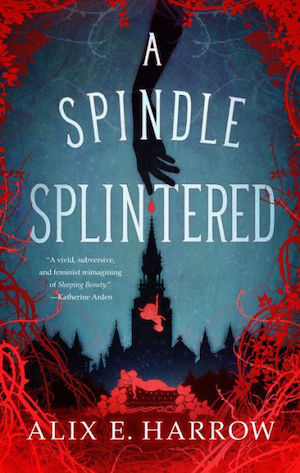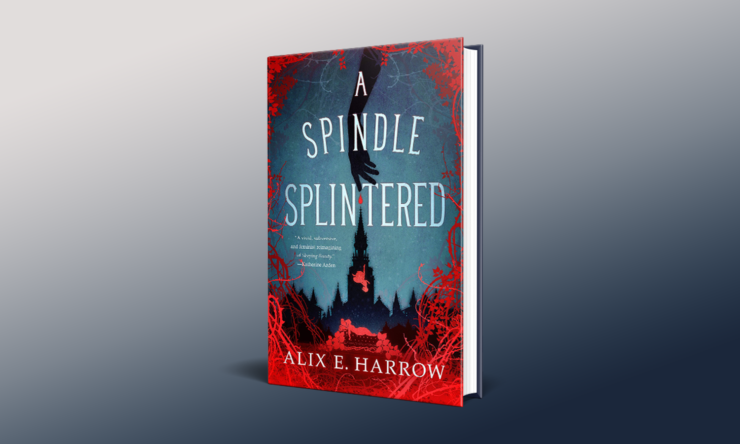One of the most cutting details in Alix E. Harrow’s A Spindle Splintered is when self-described “dying girl” Zinnia Gray reflects on how she used up her Make-a-Wish at age 11 to spend one night as a Disney princess. By then, it was already too late: She could see past the too-accurate costumes and practiced smiles to the emptiness of her future, fated to die by age 21. Cosplaying as a cursed maiden didn’t do anything to lift her real-life curse of amyloidosis, caused by corrupt corporations stirring up environmental toxins. It’s a brutal anecdote because the truth is as clear as the proteins that have taken root in her lungs.
Zinnia thinks she’s wasted her one wish—until the night of what should be her final birthday, when she pricks a spindle for the hell of it and winds up in the Sleeping Beauty multiverse. The first installment of Harrow’s Spider-Man: Into the Spider-Verse remix on classic fairy tales is an engaging (if at times overly zippy) adventure that sets up exactly what every fairy tale needs: A heroine who is out of fucks to give.
It’s a morbidly clever choice to cast the pop culture archetype of the terminally ill girl as Sleeping Beauty: Zinnia has spent so much of her short life confined to hospital beds and endlessly pricked by needles that the fairy tale’s iconic aspects have long since lost their romantic sheen. As her own personal Doomsday Clock has ticked closer to midnight, she’s coped by establishing stringent rules so as to limit the blast radius when she inevitably succumbs to her incurable curse. Exhausted cynicism would keep her from voluntarily drawing even one more drop of blood, if she weren’t also humoring her best friend Charmaine and her birthday surprise (when not even her special day is entirely her own).
Buy the Book


A Spindle Splintered
That drop of blood becomes ink on the pages of the universe, as Zinnia gets shuffled from her own world into a parallel one that couldn’t be more of a contrast: an imposing castle with an impossibly ethereal princess who is moments away from her own finger-prick. When Zinnia stops Primrose from fulfilling her own twenty-first birthday curse, it’s not just A 21st-Century Dying Girl in Primrose’s Court, it’s a disruption of the sacred fairy tale timeline.
The resulting quest on which these polar opposites embark expands the bounds of Primrose’s kingdom beyond her pre-grieving parents’ throne room and the tower room they all know she can’t avoid forever. Harrow further adeptly uses this device to expand readers’ impressions of what possibilities exist outside of the familiar narrative. Unlike Miles Morales having to learn about other Spider-Men on the go, Zinnia has the benefit of having devoted her studies to the quirks and idiosyncracies of fairy tales, especially her quasi-namesake. This helps maintain the novella’s brisk pace, so that any new information obtained on their travels is specific to her and Primrose’s particular dilemma, as opposed to repeating what we already know. The truths that they uncover are a keenly sharp commentary that feels both timeless and very much rooted in current conversations about childbearing people’s bodily autonomy.
The novella’s length does dictate some reliance on overly recognizable narrative shorthand, however. For all that Zinnia watches Primrose react to her world opening up, the princess still comes across as the physical embodiment of archetype subversion rather than her own complete person. Similarly, at times Zinnia seems to be purely defined by her snarky nihilism, which acts as the figurative wall of thorns blocking her own access to greater self-awareness. Then, of course, there’s the amyloidosis, which seems to be such an intrinsic part of her that it translates across retellings.
Zinnia’s adherence to Dying Girl Rule #3 (no romance) is a welcome emotional limit imposed upon her story arc, as it ensures that her own epic adventure does not hinge on a well-meaning love interest further stripping her of agency. But, despite her attempts at shrewd self-protection, Zinnia fails to account for love—platonic love, through her friendship with Charm. Their bond, texting across parallel universes and trolling each other through personalized PowerPoints, is the most magical aspect of the series, and one I look forward to seeing developed further.
As with Spider-Verse, this story benefits from the added dimension of illustrations: Arthur Rackham’s classic cut-paper silhouettes from a 1920 retelling of Sleeping Beauty are charmingly “splintered,” each one drawing the eye to spy its remix. In many cases, the fairy tale silhouettes marching over these pages are beheaded (bringing to mind another classic story whose Wonderland setting has been infinitely adapted), but just as often it’s a matter of switching the heads between hunters and prey, princes and princesses. Maybe, these mischievous body-swaps seem to suggest, it’s time for these archetypes to try on new roles.
“You are accustomed to thinking of fairy tales as make-believe,” Zinnia recalls from a professor’s lecture. “But they have only ever been mirrors.” A Spindle Splintered certainly reveals clever glimpses, but Harrow seems to promise even deeper self-reflection in the forthcoming sequel A Mirror Mended, and hopefully increasingly more inspired adventures in the fairy tale multiverse.
A Spindle Splintered is available from Tordotcom Publishing.
Natalie Zutter is a playwright and pop culture critic based in Brooklyn. She talks about SFF books, movies, and TV on Twitter.










